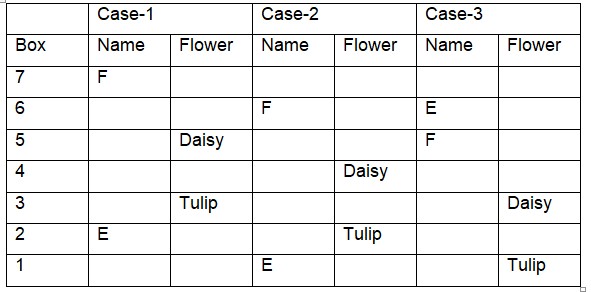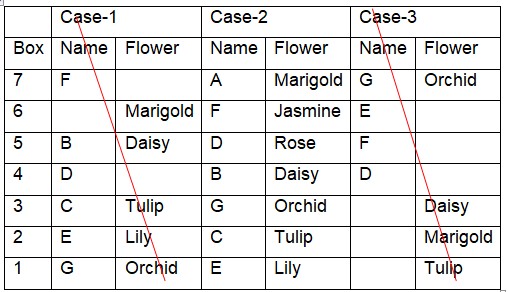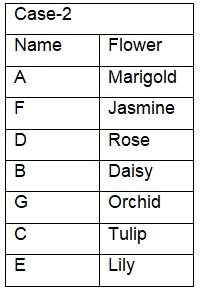Question
What is the position of the box with lily?
Answer the questions based on the information given below. Seven boxes viz. A, B, C, D, E, F and G are filled with different flowers viz. Rose, Lily, Jasmine, Orchid, Daisy, Tulip and Marigold are kept one above another in a stack. The box kept at the lowermost position is numbered as 1 and the box kept at the topmost position is numbered as 7. Box F is kept four boxes above the box with tulip where the box with daisy is kept exactly in the middle between them. Only two boxes are kept between the box with daisy and box E which is not kept at the topmost position. As many boxes kept above box E as below the box with Marigold which is kept two boxes away from box D. Box G with orchid is kept at an odd numbered position. Box C is kept immediately above the box with lily and two boxes below box B. The box with rose is kept immediately below the box with jasmine.Solution
Box F is kept four boxes above the box with tulip where the box with daisy is kept exactly in the middle between them. Only two boxes are kept between the box with daisy and box E which is not kept at the topmost position.  As many boxes kept above box E as below the box with Marigold which is kept two boxes away from box D. Box G with orchid is kept at an odd numbered position.
As many boxes kept above box E as below the box with Marigold which is kept two boxes away from box D. Box G with orchid is kept at an odd numbered position.  Box C is kept immediately above the box with lily and two boxes below box B. The box with rose is kept immediately below the box with jasmine. Hence, cases 1 and 3 get eliminated
Box C is kept immediately above the box with lily and two boxes below box B. The box with rose is kept immediately below the box with jasmine. Hence, cases 1 and 3 get eliminated  So final arrangement-
So final arrangement- 
In two-phase locking, a transaction releases its locks:
A relation is in 2NF if:
Which of the following is a type of database index?
Which normal form removes partial dependency?
Distributed 2-Phase Commit (2PC) can suffer from:
A view in SQL is:
Which of the following is a DML command?
Which normal form eliminates transitive dependency?
Which of the following is a transaction property ensuring all steps are completed or none?
Which of the following schedules is serializable?
Relevant for Exams:


